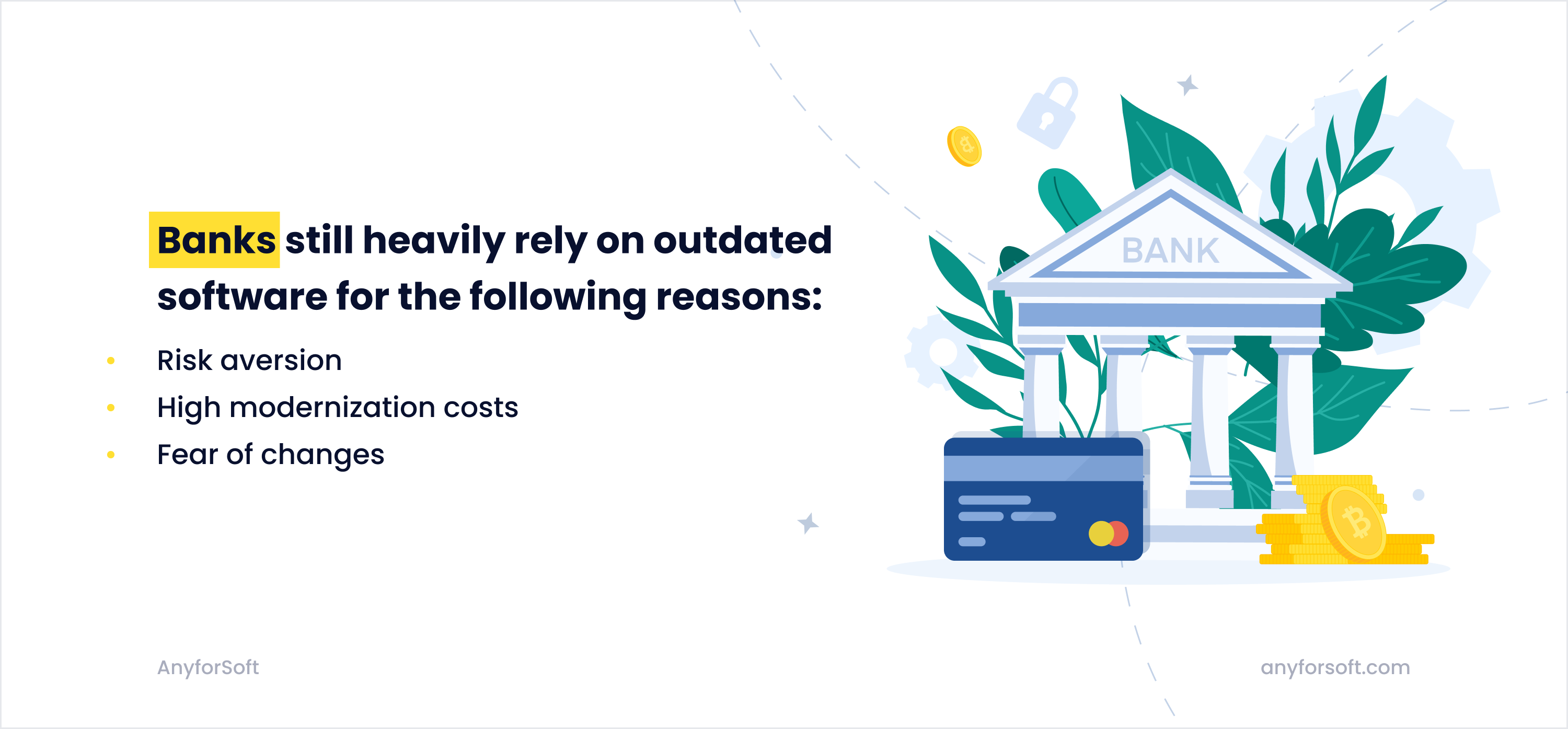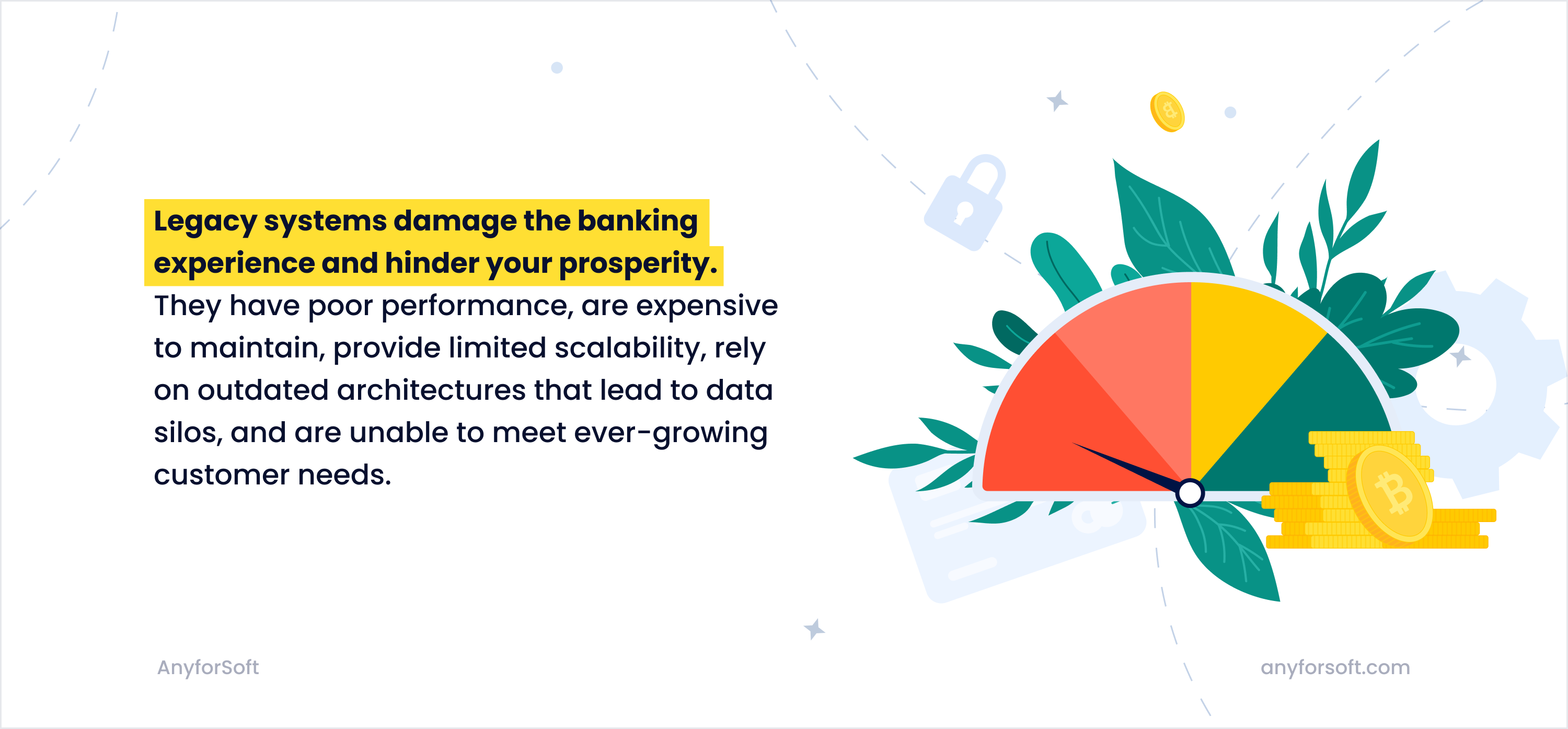In one of our recent articles, we discussed legacy application modernization and the problems outdated systems bring to businesses. In this blog post, we would like to narrow down our focus and talk about legacy technologies in the banking sector.
You see, most banking organizations recognize the importance of digital transformation. Yet only 43% commit to upgrading their legacy core systems and applications.
Why does this happen? What stops banks from modernizing their legacy systems? And, more importantly, how outdated software undermines financial institutions?
This article aims to answer all of these questions. As a customer-centric fintech software development company, AnyforSoft cares about your success and wants to bring benefit to your banking institution. That’s why today we want to discuss how your legacy banking system holds you down and, hopefully, convince you to upgrade. Don’t skip this blog post, as it will encourage you to embrace digital transformation.
Let’s dive right in!
What is a legacy banking system?

A legacy financial system is banking/financial software developed using outdated technologies, programming languages, or frameworks. In general, any system that has reached its end of life, no longer receives updates and security patches, can’t be scaled, or relies on outdated architecture can be considered a legacy system.
For example, Drupal 8 is a legacy product, as the community no longer supports it.
Why legacy systems in banking are still used?
The banking industry still heavily relies on outdated platforms, technologies, and frameworks.
But why? Why don’t banks invest in legacy banking system modernization and improve their business processes as well as customer experience?
Well, we can think of at least three reasons:
- Risk aversion. According to Reuters, outdated COBOL systems process over $3 trillion on a daily basis. Just to remind you, COBOL is a programming language created more than 64 (!) years ago. When the stakes are that high, it is no surprise that banking organizations and financial institutions are reluctant to modernizing legacy systems. Digital transformation implies disruptions in the work of your organization, and if you process thousands of transactions daily, it’s only natural that you don’t want to disrupt that flow.
- High costs. The modernization of banking legacy systems requires significant upfront investments. Small financial organizations simply don’t have enough budget to embrace new technologies. However, maintaining and supporting outdated systems proves to be more expensive in the long run. Thus, even if you have a very tight budget, consider saving up money and investing in digital transformation.
- Fear of changes. Product innovation always comes with changes in a company’s business processes. It brings the need to learn and adapt to new workflows. For instance, if you want to implement artificial intelligence and machine learning in Fintech apps, your team has to be well-versed in Python development (and if your team doesn’t have such expertise, you will have to find and hire developers for your startup with Python experience). Changes like this can be uncomfortable for you, your employees and stakeholders, discouraging you from embracing new technologies.

But even though legacy banking system modernization comes with its challenges and may seem like a lot of work, not investing in it is a serious mistake that could undermine your organization.
How Legacy Core Banking Systems Hinder Your Success
Legacy systems in banking damage the banking experience and hinder your success in many ways.
Poor performance
Legacy core banking systems and platforms are slow and inefficient, frustrating your customers and employees alike. If your clients experience disruptions or delays while using your banking services, they’re likely to go to your competitor. The same is true for your employees. Poor system performance negatively impacts the morale in your workplace, which may force your team members to leave your organization. All of this leads to loss of revenue, productivity, and, eventually, market share.
Ongoing maintenance cost
Relying on outdated software implies ongoing maintenance expenses. If the system you use is no longer supported by the vendor, that means all the maintenance, upgrades, and security patches fall on your shoulders.
Considering that financial organizations deal with sensitive data (customer credit card information, account balances, cashflows, etc.), you can’t leave your company unprotected from fintech cybersecurity threats. Besides, ensuring regulatory compliance with the government regulations in your country is a must for any financial organization.
However, when you rely on cloud-based technologies, security updates and maintenance measures become the responsibility of your provider, saving you tons of money and effort. That’s why many businesses are considering cloud migration these days.
Limited scalability
Working with legacy core banking systems always comes with scalability issues. The systems created long ago simply can’t handle the exponentially growing data exchanges and transactions. As a result, the more customers your organization has, the more slow your system becomes, disrupting your financial operations.
Your resistance to embracing digital transformation gives your rivals a competitive advantage; a new bank may enter the market and lure away your clients by offering more effective and efficient solutions that your organization and other traditional banks can’t provide. That’s another good reason to invest in legacy banking system modernization.
Outdated data architecture
The design and architecture of banking systems date back to the 1980s. By the 1990s, organizations had adopted the client-server model, which introduced data silos due to poor integration between back-end and front-end components. Consequently, many banks today rely on technologies that are challenging to integrate with each other. Older banking platforms, for example, use FTP protocols to transfer data from the front end to middleware platforms, whereas modern systems use web services.
Given that new technologies appear at a rapid pace, it becomes harder to integrate an older technology with a newer one. The lack of integration results in lower conversions, as analytics and reporting capabilities that banks rely on to make strategic decisions are limited.
Inability to meet evolving customer demands
One of the most frustrating challenges that legacy systems present to you is the inability to meet evolving customer needs and demands. Modern users of bank services are social and mobile people who are always on the go. Hence, they expect your services to also be “mobile” and cater to their needs.
However, legacy systems are challenging to use on mobile devices. What’s more, many banks don’t have mobile apps and are not even considering investing in mobile development. Financial services companies that do offer mobile applications often don’t support advanced features their customers need, resulting in a bad user experience.
If you don’t want to lose your customers, you need to upgrade your legacy banking system and ensure it works great across all devices, both desktop and mobile.

Modernize your legacy banking system with AnyforSoft
We hope you enjoyed this article and now understand the importance of digital transformation.
Even though legacy system modernization comes with its challenges, you shouldn’t hesitate to upgrade. The more you wait, the more time you give to your competitors to outperform you.
Don’t let them lure away your customers. Modernize your outdated banking system and provide better financial services!
As a customer-oriented company with over 12 years of experience, AnyforSoft creates software solutions of any complexity and can help you implement your idea. Thanks to broad expertise in modern frameworks and programming languages, we can upgrade your legacy systems while ensuring that the new software fully meets your business needs and requirements.
Contact us today and tell us about your project.
